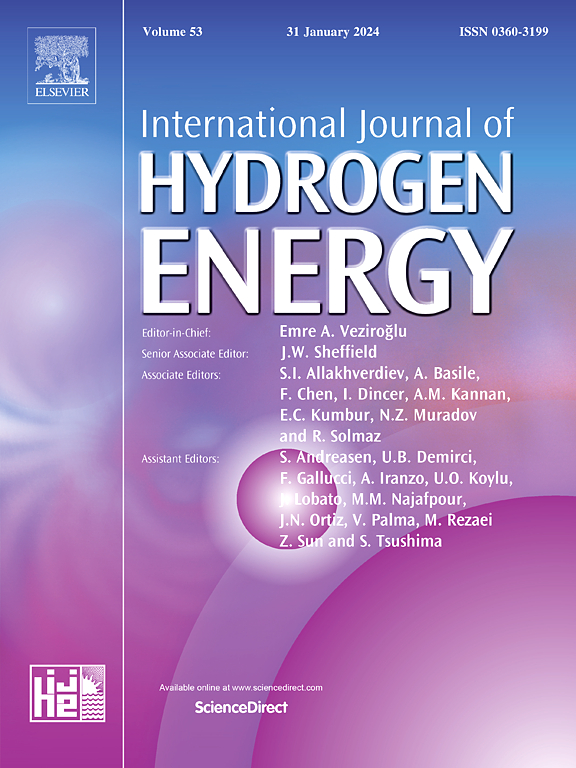Calibration facilities and test results for gas network hydrogen and hydrogen enriched natural gas flow meters
IF 8.3
2区 工程技术
Q1 CHEMISTRY, PHYSICAL
引用次数: 0
Abstract
The transition to a decarbonized gas network requires the adaptation of existing infrastructure to accommodate hydrogen and hydrogen-enriched natural gas. This study presents the development of calibration facilities at NEL, VSL, and DNV for evaluating the performance of flow meters under hydrogen conditions. Nine flow meters were tested, covering applications from household consumption to distribution networks. Results demonstrated that rotary displacement meters and diaphragm meters are typically suitable for hydrogen and hydrogen-enriched natural gas domestic and commercial consumers use. Tests results for an orifice meter confirmed that a discharge coefficient calibrated with nitrogen can be reliably used for hydrogen by matching Reynolds numbers. Thermal mass flow meters, when not configured for the specific test gas, exhibited significant errors emphasizing the necessity of gas-specific calibration and configuration. Turbine meters showed predictable error trends influenced by Reynolds number and bearing friction, with natural gas calibration providing reliable hydrogen and hydrogen-enriched natural gas performance in the Reynolds domain. It was confirmed that ultrasonic meter performance varies by manufacturers, with some meter models requiring a correction for gas composition bias when used in hydrogen enriched natural gas applications. These findings provide critical experimental data to guide future hydrogen metering standards and infrastructure adaptations, supporting the European Union's goal of integrating hydrogen into the gas network.
燃气管网氢气及富氢天然气流量计标定设施及检测结果
向脱碳天然气网络的过渡需要对现有基础设施进行改造,以容纳氢气和富氢天然气。本研究介绍了NEL、VSL和DNV校准设备的发展,用于评估氢气条件下流量计的性能。测试了9个流量计,涵盖了从家庭消费到配电网的应用。结果表明,旋转位移表和隔膜表通常适用于氢气和富氢天然气的家庭和商业用户使用。对孔板流量计的测试结果证实,通过匹配雷诺数,用氮气校准的放电系数可以可靠地用于氢气。热质量流量计,当没有为特定的测试气体配置时,显示出明显的误差,强调了特定气体校准和配置的必要性。涡轮仪表显示出受雷诺数和轴承摩擦影响的可预测误差趋势,天然气校准在雷诺域提供可靠的氢气和富氢天然气性能。经证实,超声波仪表的性能因制造商而异,当用于富氢天然气应用时,一些仪表型号需要对气体成分偏差进行校正。这些发现为指导未来的氢气计量标准和基础设施改造提供了关键的实验数据,支持欧盟将氢气纳入天然气网络的目标。
本文章由计算机程序翻译,如有差异,请以英文原文为准。
求助全文
约1分钟内获得全文
求助全文
来源期刊

International Journal of Hydrogen Energy
工程技术-环境科学
CiteScore
13.50
自引率
25.00%
发文量
3502
审稿时长
60 days
期刊介绍:
The objective of the International Journal of Hydrogen Energy is to facilitate the exchange of new ideas, technological advancements, and research findings in the field of Hydrogen Energy among scientists and engineers worldwide. This journal showcases original research, both analytical and experimental, covering various aspects of Hydrogen Energy. These include production, storage, transmission, utilization, enabling technologies, environmental impact, economic considerations, and global perspectives on hydrogen and its carriers such as NH3, CH4, alcohols, etc.
The utilization aspect encompasses various methods such as thermochemical (combustion), photochemical, electrochemical (fuel cells), and nuclear conversion of hydrogen, hydrogen isotopes, and hydrogen carriers into thermal, mechanical, and electrical energies. The applications of these energies can be found in transportation (including aerospace), industrial, commercial, and residential sectors.
 求助内容:
求助内容: 应助结果提醒方式:
应助结果提醒方式:


